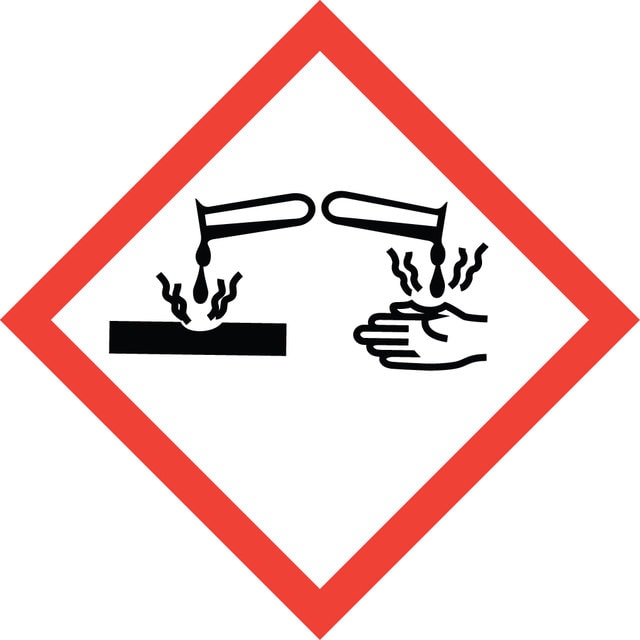If this product has an expiration or retest date, it will be shown on the Certificate of Analysis (COA, CofA). If there is no retest or expiration date listed on the product's COA, we do not have suitable stability data to determine a shelf life. For these products, the only date on the COA will be the release date; a retest, expiration, or use-by-date will not be displayed.
For all products, we recommend handling per defined conditions as printed in our product literature and website product descriptions. We recommend that products should be routinely inspected by customers to ensure they perform as expected.
For products without retest or expiration dates, our standard warranty of 1 year from the date of shipment is applicable.
For more information, please refer to the Product Dating Information document: https://www.sigmaaldrich.com/deepweb/assets/sigmaaldrich/marketing/global/documents/418/501/product-dating-information-06-25-mk.pdf
Wybierz wielkość
325,00 zł
1080,00 zł
3230,00 zł
325,00 zł
Informacje o tej pozycji
Przejdź do
Nazwa produktu
Sodium dodecyl sulfate, BioXtra, ≥99.0% (GC)
InChI key
DBMJMQXJHONAFJ-UHFFFAOYSA-M
InChI
1S/C12H26O4S.Na/c1-2-3-4-5-6-7-8-9-10-11-12-16-17(13,14)15;/h2-12H2,1H3,(H,13,14,15);/q;+1/p-1
SMILES string
[Na+].CCCCCCCCCCCCOS([O-])(=O)=O
biological source
synthetic (oragnic)
description
anionic
product line
BioXtra
assay
≥99.0% (GC)
form
powder
mol wt
micellar avg mol wt 18,000
Quality Level
greener alternative product characteristics
Catalysis
Learn more about the Principles of Green Chemistry.
sustainability
Greener Alternative Product
aggregation number
62
impurities
Insoluble matter, passes filter test
loss
≤0.5% loss on drying, HV, 20-25 °C
CMC
7-10 mM (20-25°C)
mp
204-207 °C (lit.)
transition temp
cloud point >100 °C
solubility
H2O: 0.1 M, clear, colorless
density
0.496 g/cm3
anion traces
chloride (Cl-): ≤0.05%
phosphate (PO43-): ≤0.0001%
cation traces
Al: ≤0.0005%
Ba: ≤0.0005%
Bi: ≤0.0005%
Ca: ≤0.001%
Cd: ≤0.0005%
Co: ≤0.0005%
Cr: ≤0.0005%
Cu: ≤0.0005%
Fe: ≤0.0005%
K: ≤0.02%
Li: ≤0.0005%
Mg: ≤0.0005%
Mn: ≤0.0005%
Mo: ≤0.0005%
Ni: ≤0.0005%
Pb: ≤0.0005%
Sr: ≤0.0005%
Zn: ≤0.0005%
absorption
≤0.05 at 280 in H2O at 0.1 M
≤0.08 at 260 in H2O at 0.1 M
HLB
40
greener alternative category
Szukasz podobnych produktów? Odwiedź Przewodnik dotyczący porównywania produktów
1 of 4
Ta pozycja | L3771 | 75746 | 71726 |
|---|---|---|---|
| form powder | form powder | form rod | form rod |
| assay ≥99.0% (GC) | assay ≥98.5% (GC) | assay ≥99.0% (GC) | assay ≥99.0% (GC) |
| aggregation number 62 | aggregation number 62 | aggregation number 62 | aggregation number - |
| cation traces Al: ≤0.0005%, Bi: ≤0.0005%, Cd: ≤0.0005%, Cr: ≤0.0005%, Fe: ≤0.0005%, Li: ≤0.0005%, Mn: ≤0.0005%, Ni: ≤0.0005%, Sr: ≤0.0005%, Ba: ≤0.0005%, Co: ≤0.0005%, K: ≤0.02%, Mo: ≤0.0005%, Zn: ≤0.0005%, Ca: ≤0.001%, Mg: ≤0.0005%, Cu: ≤0.0005%, Pb: ≤0.0005% | cation traces heavy metals (as Pb): ≤10 ppm | cation traces Ca: ≤25 mg/kg, Cd: ≤5 mg/kg, Co: ≤5 mg/kg, Cr: ≤5 mg/kg, Cu: ≤5 mg/kg, Fe: ≤10 mg/kg, K: ≤200 mg/kg, Mg: ≤20 mg/kg, Mn: ≤5 mg/kg, Ni: ≤5 mg/kg, Pb: ≤5 mg/kg, Zn: ≤5 mg/kg | cation traces - |
| description anionic | description anionic | description anionic | description anionic, 62 |
| HLB 40 | HLB 40 | HLB 40(lit.) | HLB 40 |
Application
Features and Benefits
- Tested to confirm low levels of heavy metal contamination, ensuring suitability for various applications
- Tested for trace levels of Anions and Cations
- High-purity product ideal for biochemical research purposes
General description
Other Notes
comparable product
signalword
Danger
hcodes
Hazard Classifications
Acute Tox. 4 Oral - Aquatic Chronic 3 - Eye Dam. 1 - Skin Irrit. 2
Klasa składowania
11 - Combustible Solids
wgk
WGK 2
flash_point_f
338.0 °F
flash_point_c
170 °C
ppe
Eyeshields, Faceshields, Gloves, type P3 (EN 143) respirator cartridges
Wybierz jedną z najnowszych wersji:
Masz już ten produkt?
Dokumenty związane z niedawno zakupionymi produktami zostały zamieszczone w Bibliotece dokumentów.
-
How can I determine the shelf life / expiration / retest date of this product?
1 answer-
Helpful?
-
-
How is shipping temperature determined? And how is it related to the product storage temperature?
1 answer-
Products may be shipped at a different temperature than the recommended long-term storage temperature. If the product quality is sensitive to short-term exposure to conditions other than the recommended long-term storage, it will be shipped on wet or dry-ice. If the product quality is NOT affected by short-term exposure to conditions other than the recommended long-term storage, it will be shipped at ambient temperature. As shipping routes are configured for minimum transit times, shipping at ambient temperature helps control shipping costs for our customers. For more information, please refer to the Storage and Transport Conditions document: https://www.sigmaaldrich.com/deepweb/assets/sigmaaldrich/marketing/global/documents/316/622/storage-transport-conditions-mk.pdf
Helpful?
-
Active Filters
Nasz zespół naukowców ma doświadczenie we wszystkich obszarach badań, w tym w naukach przyrodniczych, materiałoznawstwie, syntezie chemicznej, chromatografii, analityce i wielu innych dziedzinach.
Skontaktuj się z zespołem ds. pomocy technicznej

